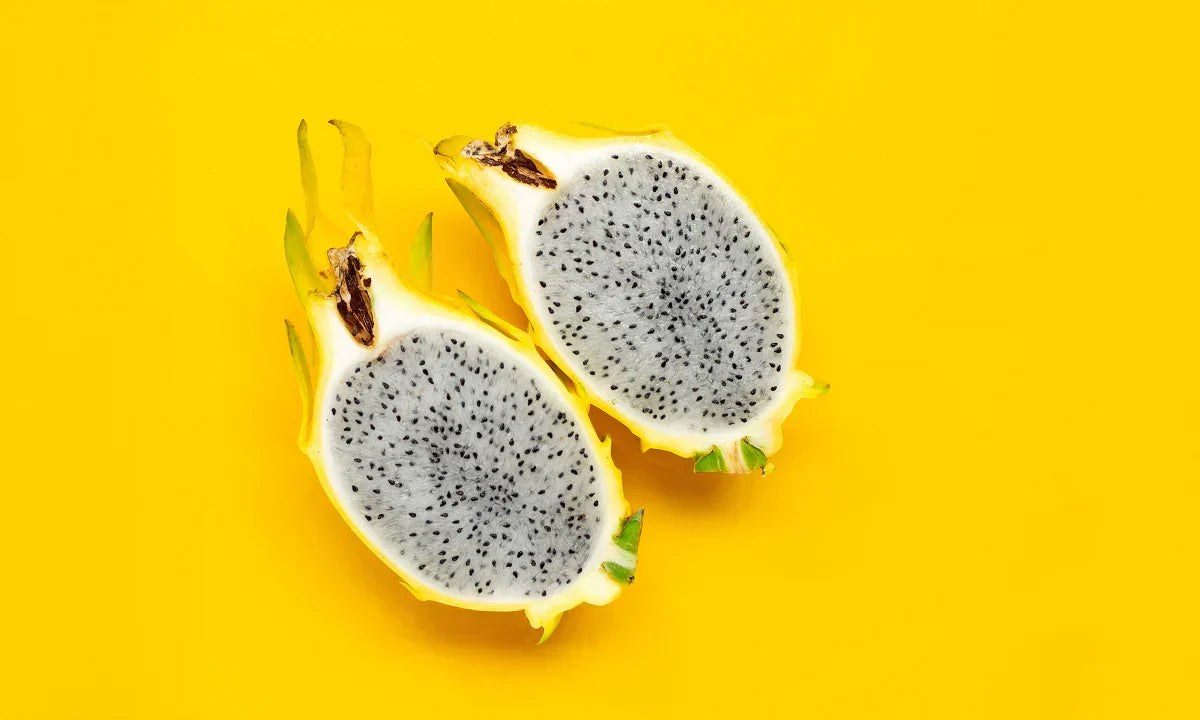Estimated Reading Time: 7 minutes
|If you've ever walked past a spiky yellow fruit at the store and thought, what is that? - you're not alone. Yellow dragon fruit looks exotic, but it's surprisingly easy to enjoy. With its naturally sweet taste and refreshing texture, it has become a favorite among fruit lovers seeking to try something new without straying too far from familiar flavors.
Whether you're curious about its nutritional benefits or just want something refreshing to mix into your fruit bowl, yellow dragon fruit checks both boxes; it's juicy, subtly sweet, and surprisingly gentle on the stomach.
In this blog, we will take a closer look at what yellow dragon fruit is, where it comes from, and why it might deserve a spot in your kitchen.
What Is Yellow Dragon Fruit?
Yellow dragon fruit, also known as yellow pitaya, is a tropical fruit characterized by its bright yellow skin and soft, white flesh dotted with small black seeds. Compared to the red type, it has a sweeter taste and a stronger aroma.
It comes from parts of South America, including Peru, Colombia, Ecuador, Bolivia, and Venezuela. Today, it's grown in many tropical regions.
This fruit is low in calories and provides natural sugars, fiber, and a bit of protein. A 100 - gram serving has about 13 grams of carbs, 1.3 grams of fiber, and almost no fat.
How Yellow Dragon Fruit May Benefit You
So, what can yellow pitaya actually do for your body? Here are the areas it may support.
Gut Health and Microbiome Support
-
Yellow dragon fruit contains fiber and prebiotics that nourish beneficial gut bacteria. Early studies suggest that it may improve the balance of microbes by increasing beneficial ones and reducing harmful types, such as E. coli.
-
Researchers also observed an increase in IgA, an antibody that helps protect the gut lining and supports the immune system.
Immune health
-
There's more to yellow pitaya than its bright skin and sweet flavor. It's got some vitamin C, plus plant - based compounds your body can actually use.
-
In one study, individuals who consumed specific parts of the fruit experienced an increase in IgA, an antibody associated with gut defenses. That suggests it might help reinforce your immune barriers, especially in the gut.
-
Vitamin C also plays a well - documented role in the function of white blood cells. Fruits like pitaya, rich in C and natural polyphenols, are a smart addition when you're looking to stay well or recover faster.
Also Read: The 8 Best Foods to Boost Your Immune Health
Antioxidants and Inflammation
-
Pitaya's bright color is derived from natural compounds, including flavonoids and betalains. These plant pigments help your body handle oxidative stress, the kind that builds up from poor diet, stress, or just daily life.
-
Recent research suggests that yellow pitaya may help alleviate low - grade inflammation, a type that develops gradually and can impact your overall well - being over time.
-
Antioxidants in the fruit may play a role in reducing long - term inflammation associated with conditions such as heart disease, diabetes, and metabolic disorders. Red varieties contain betalains, which are linked to lower cholesterol and inflammation, while yellow pitaya has similar yellow - orange pigments called betaxanthins.
Blood sugar and metabolism
-
Pitaya contains fiber and natural carbs called oligosaccharides that may help steady blood sugar levels. Some early studies, both in people and animals, have shown that parts of the fruit can support better blood sugar control.
-
In one human trial, fiber from dragon fruit helped lower insulin levels and reduce calorie intake in overweight individuals.
-
One animal study involving red pitaya found that regular intake helped lower blood sugar levels and improved the body's response to insulin. Although more research is needed, the fiber and low glycemic impact of yellow pitaya make it a suitable fruit choice for individuals monitoring their blood sugar levels.
Cholesterol and heart health
-
Research on yellow pitaya in humans is still limited, but studies using red dragon fruit in animals have shown encouraging results.
-
In one animal study, rats with high cholesterol were fed red pitaya daily. Over time, their total and LDL cholesterol levels decreased while HDL levels increased. Triglyceride levels improved, too. Researchers attributed the fruit's beneficial properties to its fiber and antioxidant content.
Since yellow pitaya has a similar nutrient profile, it can offer comparable benefits when included as part of an overall balanced diet.
How to Enjoy Yellow Dragon Fruit
-
Choosing a ripe one:
Pick yellow dragon fruits with vibrant skin and small orange or brown freckles. These spots indicate that the fruit is ripe and ready to eat. The fruit tastes good when it's soft. If it's too firm or has mushy spots, mold, or wrinkled skin, it's best to skip it.
-
Getting it ready to eat:
Start by rinsing the fruit under cool water. Slice it lengthwise down the middle. From there, you can either scoop out the flesh with a spoon - just like you would with an avocado - or peel the skin away to get to the pulp.
The white flesh is juicy and slightly sweet, with a flavor similar to kiwi and pear. You can dice it into fruit salads, toss it into a smoothie, or just enjoy it straight from the spoon.
-
Ways to enjoy it:
Yellow dragon fruit works well in all kinds of dishes. It adds a pop of color and a bit of natural sweetness wherever you use it. Its light sweetness makes it a great match with tropical fruits like mango or pineapple or even berries in smoothies. Here are some fun ways to indulge:
-
Add a few pieces to the yogurt and enjoy it while it's chilling.
-
Stir it into oatmeal for a healthier option.
-
Mix it into a fresh salad.
-
Freeze the pulp into ice pops or blend it with banana and coconut milk for a tropical sorbet.
-
You can even grill thick slices or mix them into salsa.
Due to its striking appearance, it makes a beautiful garnish for both desserts and drinks.
-
Storage:
Keep uncut dragon fruit at room temperature for a couple of days until it ripens. Once ripe, you can refrigerate it whole for up to a week. After cutting, store the flesh in an airtight container in the refrigerator and use it within a couple of days for optimal flavor.
Precautions and Allergies
Yellow dragon fruit is generally safe for most people when consumed as food, but a few precautions are advisable.
-
It is high in natural sugars, so people with diabetes should enjoy it in moderation (though its fiber content can help slow sugar absorption).
-
Eating very large amounts (several servings) of fiber - rich fruit may cause mild digestive upset (gas or diarrhea) in some individuals.
-
Allergic reactions to dragon fruit aren't common, but they can happen. Some people have reported symptoms like itching, hives, or, in rare cases, a severe reaction known as anaphylaxis.
Summary
Yellow dragon fruit is a refreshing, hydrating fruit rich in fiber, vitamin C, and antioxidants. Research suggests it can support gut health, boost immunity (via IgA), and contribute to antioxidant defenses. It may also contribute to improved metabolic health - for example, by reducing cholesterol and insulin levels. It makes a colorful, tasty addition to smoothies, salads, and snacks. As with any food, enjoy it as part of a balanced diet and be aware of rare allergies.
Disclaimer: This blog is intended for educational purposes only and is not a substitute for professional medical advice. The Food and Drug Administration has not evaluated the statements made in this content. Products or ingredients discussed are not intended to diagnose, treat, cure, or prevent any disease.
References
-
Shah K, Chen J, Chen J, Qin Y. Pitaya Nutrition, Biology, and Biotechnology: A Review. International Journal of Molecular Sciences. 2023;24(18):13986 - 13986. doi:https://doi.org/10.3390/ijms241813986
-
Pansai N, Detarun P, Chinnaworn A, Sangsupawanich P, Wichienchot S. Effects of dragon fruit oligosaccharides on immunity, gut microbiome, and their metabolites in healthy adults - A randomized, double - blind placebo - controlled study. Food Research International. 2023;167:112657. doi:https://doi.org/10.1016/j.foodres.2023.112657
-
Martin H, Stepaniuk P. Pitaya allergy: a case report of anaphylaxis in a patient without cross - reactive allergens. Allergy, asthma, and clinical immunology: official journal of the Canadian Society of Allergy and Clinical Immunology. 2025;21(1):21. doi:https://doi.org/10.1186/s13223 - 025 - 00962 - 7
-
Pansai N, Detarun P, Chinnaworn A, Sangsupawanich P, Wichienchot S. Effects of dragon fruit oligosaccharides on immunity, gut microbiome, and their metabolites in healthy adults - A randomized, double - blind placebo - controlled study. Food Research International. 2023;167:112657. doi:https://doi.org/10.1016/j.foodres.2023.112657






































